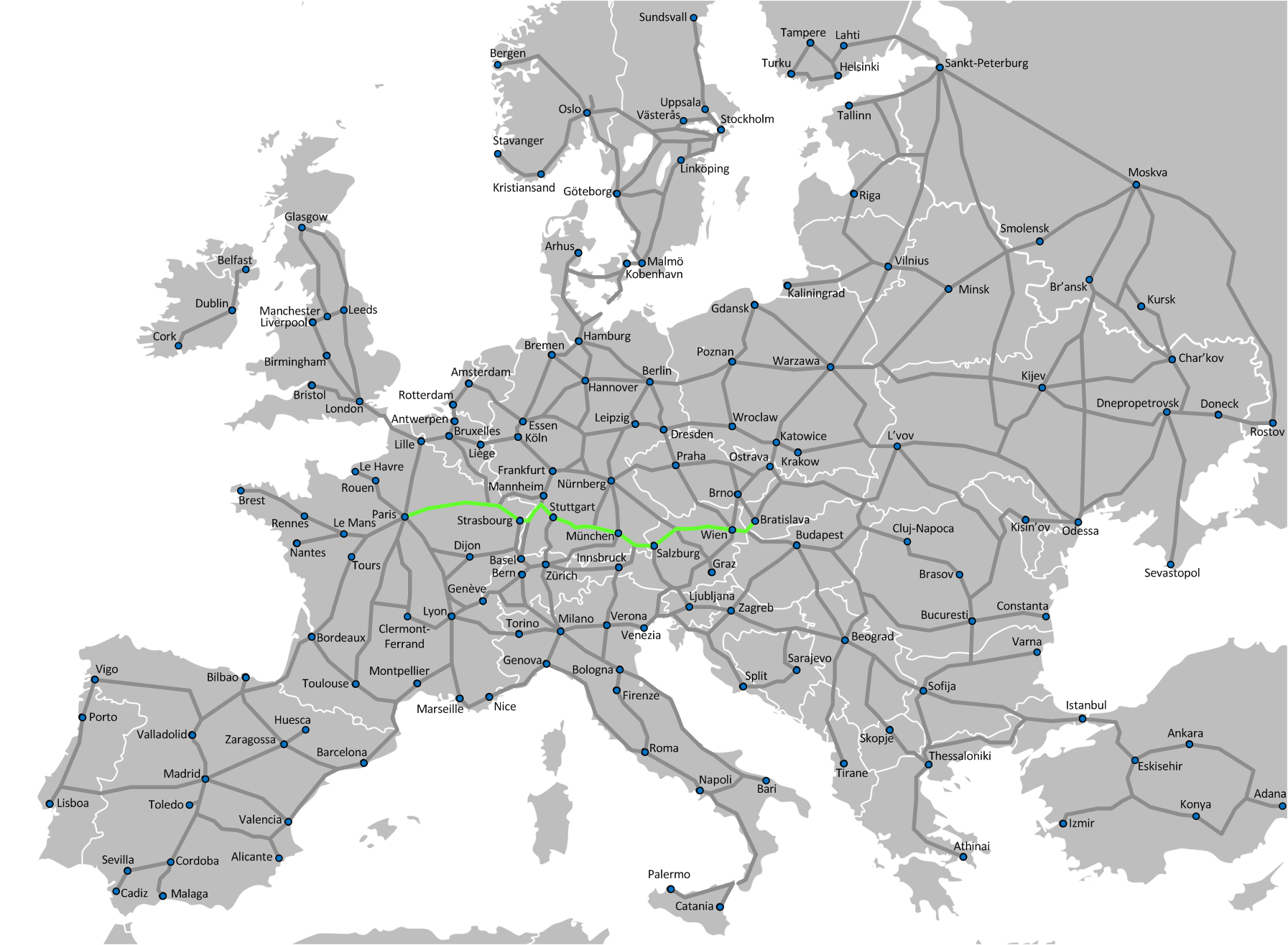Trans-European High-speed Rail Network on:
[Wikipedia]
[Google]
[Amazon]
The Trans-European high-speed rail network (TEN-R), together with the Trans-European conventional rail network, make up the Trans-European Rail network, which in turn is one of a number of the 

 * Corridor 1 – Berlin–Palermo
* Corridor 2 –
* Corridor 1 – Berlin–Palermo
* Corridor 2 –
European Union
The European Union (EU) is a supranational political and economic union of member states that are located primarily in Europe. The union has a total area of and an estimated total population of about 447million. The EU has often been des ...
's Trans-European transport networks (TEN-T). It was defined by the Council Directive 96/48/EC of 23 July 1996.
The European Union council decision 2002/735/EC defines technical standards for interoperability of the system.
Description
The aim of thisEU Directive
The European Union (EU) is a supranational union, supranational political union, political and economic union of Member state of the European Union, member states that are located primarily in Europe, Europe. The union has a total area of ...
is to achieve the interoperability
Interoperability is a characteristic of a product or system to work with other products or systems. While the term was initially defined for information technology or systems engineering services to allow for information exchange, a broader defi ...
of the European high-speed train network at the various stages of its design, construction and operation.
The network is defined as a system consisting of a set of infrastructures, fixed installations, logistic equipment and rolling stock.
By definition of the EC decision, a high-speed line must have one of these three infrastructure characteristics:
* specially built high-speed lines equipped for speeds generally equal to or greater than 250 km/h
* specially upgraded high-speed lines equipped for speeds of the order of 200 km/h
* specially upgraded high-speed lines which have special features as a result of topographical, relief or town-planning constraints, on which the speed must be adapted to each case.
The rolling stock used on these lines must be compatible with the characteristics of the infrastructure.
Along important listed rail routes (TEN-T
The Trans-European Transport Network (TEN-T) is a planned network of roads, railways, airports and water infrastructure in the European Union. The TEN-T network is part of a wider system of Trans-European Networks (TENs), including a telecommunic ...
), the railway shall be of high speed type, either when new parts are built, or when upgrades are made. This creates a quality requirement on these projects.
Corridors

 * Corridor 1 – Berlin–Palermo
* Corridor 2 –
* Corridor 1 – Berlin–Palermo
* Corridor 2 – London
London is the capital and largest city of England and the United Kingdom, with a population of just under 9 million. It stands on the River Thames in south-east England at the head of a estuary down to the North Sea, and has been a majo ...
, Paris
Paris () is the capital and most populous city of France, with an estimated population of 2,165,423 residents in 2019 in an area of more than 105 km² (41 sq mi), making it the 30th most densely populated city in the world in 2020. S ...
, Amsterdam
Amsterdam ( , , , lit. ''The Dam on the River Amstel'') is the Capital of the Netherlands, capital and Municipalities of the Netherlands, most populous city of the Netherlands, with The Hague being the seat of government. It has a population ...
and Cologne
Cologne ( ; german: Köln ; ksh, Kölle ) is the largest city of the German western States of Germany, state of North Rhine-Westphalia (NRW) and the List of cities in Germany by population, fourth-most populous city of Germany with 1.1 m ...
to Brussels
Brussels (french: Bruxelles or ; nl, Brussel ), officially the Brussels-Capital Region (All text and all but one graphic show the English name as Brussels-Capital Region.) (french: link=no, Région de Bruxelles-Capitale; nl, link=no, Bruss ...
* Corridor 3 – Lisbon–Madrid
* Corridor 4 – LGV Est
The Ligne à Grande Vitesse Est européenne (East European High Speed Line), typically shortened to LGV Est, is a French high-speed rail line that connects Vaires-sur-Marne (near Paris) and Vendenheim (near Strasbourg). The line halved the ...
* Corridor 6 – Lyon–Budapest
* Corridor 7 – Paris–Bratislava
See also
*High-speed rail in Europe
High-speed rail (HSR) has developed in Europe as an increasingly popular and efficient means of transport. The first high-speed rail lines on the continent, built in the 1970s, 1980s, and 1990s, improved travel times on intra-national corridors. ...
* Trans-European Transport Networks
* Trans-European Road network
*Trans-European Rail network The Trans-European Rail network is made up of the Trans-European high-speed rail network as well as the Trans-European conventional rail network. The rail network is one of a number of the European Union's Trans-European transport networks (TEN-T). ...
* Trans-European conventional rail network
* Trans-European Inland Waterway network
* Motorways of the Sea
* Trans-European Seaport network
*Trans-European Airport network
The Trans-European Airport network is one of a number of the Trans-European Transport Networks (TEN-T) of the European Union.
According to Article 13 of the Decision No 1692/96/EC of the European Parliament and of the Council of 23 July 1996 on Co ...
*Trans-European Combined Transport network The Trans-European Combined Transport network is one of a number of the Trans-European Transport Networks (TEN-T) of the European Union.
According to Article 14 of the Decision No 1692/96/EC of the European Parliament and of the Council of 23 July ...
References
{{Trans-European Transport Networks Transport and the European Union High-speed rail in Europe